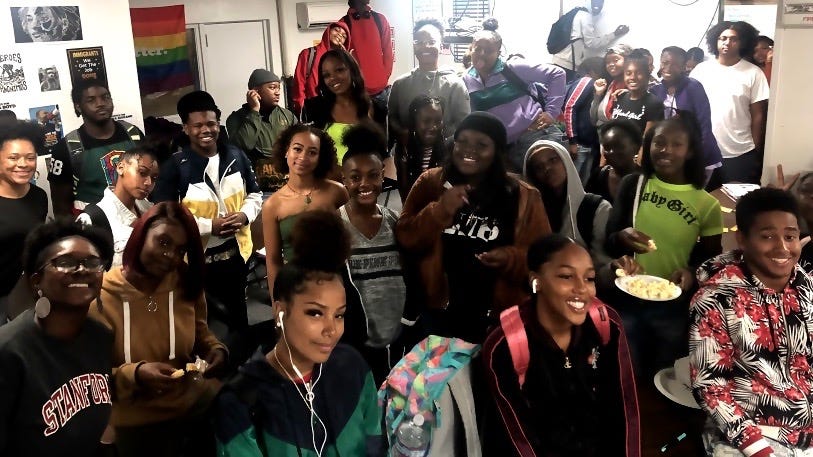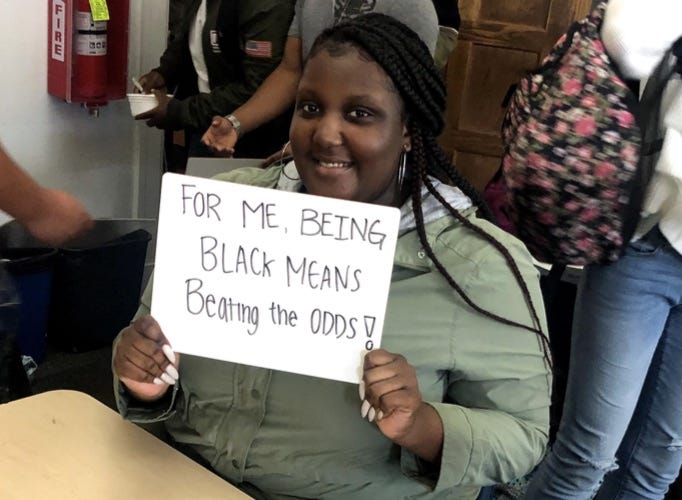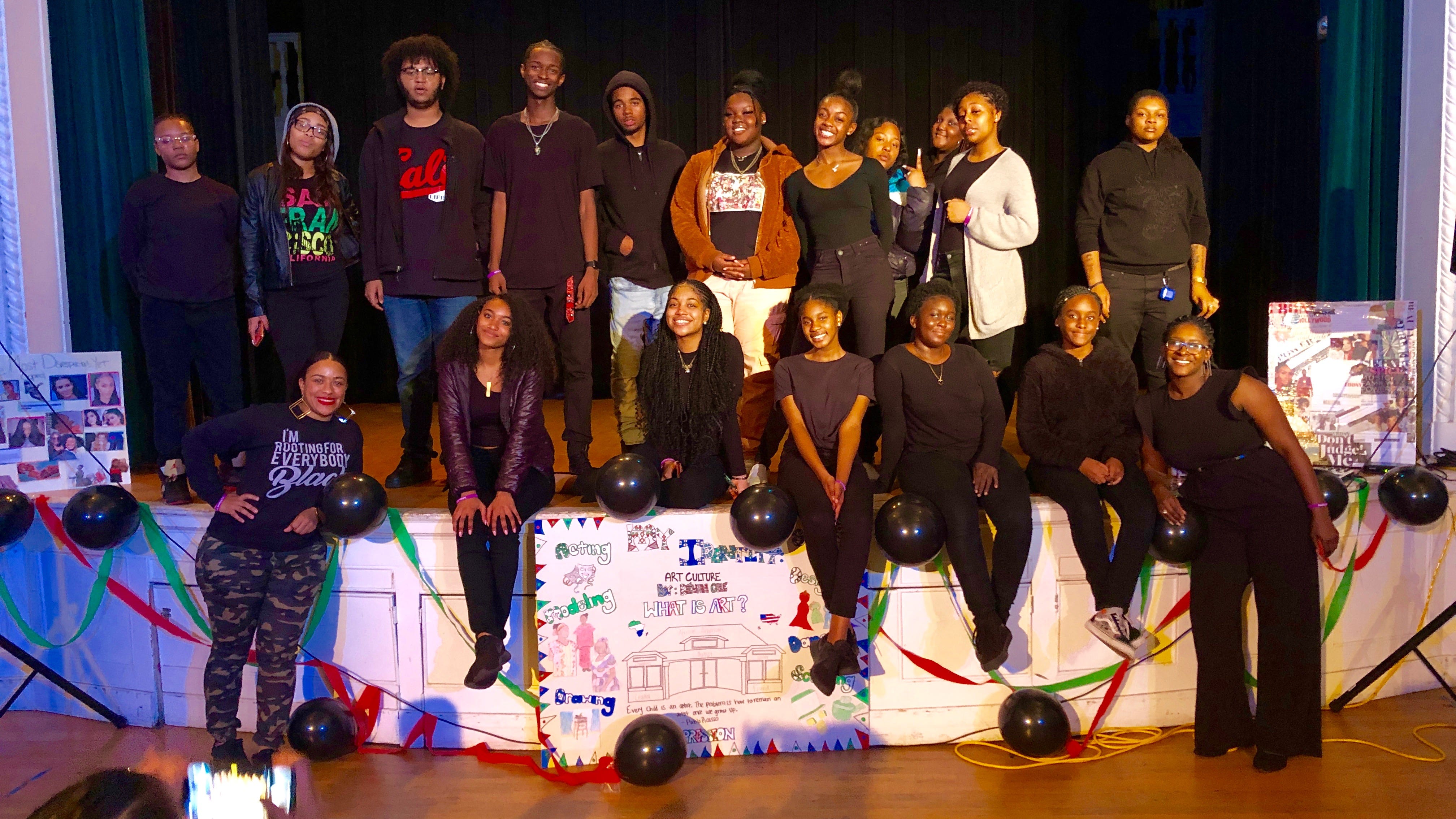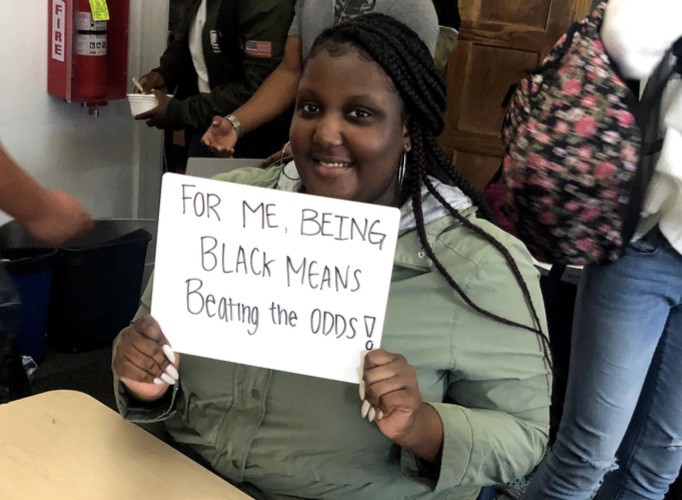A guest post from Families in Action
African American students are thriving at this school, with the highest A-G completion rate in the city and where students founded a Black Student Union

Taja looked around the room, recognizing it was a special moment. About 50 Black students at Envision Academy in Downtown Oakland coming together at the school’s first Black Student Union (BSU) meeting earlier this year, packing the classroom. The students were different ages, different grades; some friends, some putting confrontations in the past.
“It was a moment where we all came together and we hadn’t seen all the Black students together and actually having a good time in a long time,” says Taja, an Envision senior and a co-founder of Envision’s BSU. “It’s rare. I was like, ‘Wow, we did that. We put this together.’”
“It’s working out,” adds Anaya, also an Envision senior and BSU co-founder. “Like, I think it’s getting better every week.”
At the request of Anaya and Taja, the meeting began with students going around the room and introducing themselves and saying the college they want to attend (Anaya and Taja are both applying to Howard, Spelman and Clark) and what they want to major in. “Setting that expectation for the group was really awesome,” says Envision social studies teacher Ray’Von Jones, a BSU advisor.
Jones says students had talked about forming a BSU for years, but Anaya and Taja were the first to actually make it happen. “It’s really been student-led and student-driven,” adds Envision math teacher Amber Walker, also a BSU advisor. “Students are at the center and really drive what our weekly meetings are going to be about. That’s something that’s been really cool to see.”

The students approached their teachers asking for a space to unpack topics like what it means to be a Black student at Envision. “When talking about the umbrella of people of color, the different groups that are included can sometimes get mushed together, and there are some things that are very unique to being a Black person and the Black experience,” Walker says.
At that first meeting, students shared about the importance of Black teachers and admin to look to; how they can better connect with students in different grades; how they can access the support they need in class; and how are teachers showing up to make sure they’re supporting Black students.
“It’s one thing to have Black students at your school, but how they feel when they’re at your school is something people really need to think about,” Jones says. “It’s the same for work environments. People are quick to say what numbers they have, but how do people actually feel in that environment?”
From one data point, African American students are thriving more at Envision than at any other Oakland public high school. In the most recent year data is available, Envision African American students had the top A-G completion rate of any Oakland high school: 100% of the 34 Black seniors graduating in 2017–18 completed the necessary requirements to be eligible to apply to UC and CSU schools. (The school’s 96% African American graduation rate is nothing to scoff at, either.)
BSUs grew out of the civil rights movement and are actually a Bay Area original: the first BSU was formed at SF State in the late 60s. The result was the Black student population at the school doubling the year after it launched. “Everybody on the campus who identified themselves as a Black person, whether they were a student, faculty, worked in the yards, you were a member of the Black Student Union by definition,” one of the founders said, sounding much like an Envision student or teacher.
BSUs have flourished on college campuses for decades and more recently on high school campuses as well, providing students a nurturing environment and a platform to share “our identities, cultures, politics, and beliefs.”

Envision Academy’s high A-G scores and the BSU — and not just the BSU, but the school culture and conditions that exist for students to found it themselves and drive the agenda — what’s the correlation?
“I don’t know how a school can expect students to show up and perform academically if they don’t feel like they have a space where they belong, something they’re a part of,” Jones says.
“I feel like I need to show up as my best self when I’m around other Black people,” Jones adds. “Those are the people who can hold me the most accountable. I think BSU can be a space to do that, too — check on A-G requirements, talk about college.”
Walker says that the conversations and connections outside of class that Black teachers and students make “can really create a sense of belonging in a classroom.”
“I think about the safety and security that students have to feel, especially in math class, in order to make a mistake or ask a question,” Walker says. “Ultimately, all this contributes to their success, and a lot of that has to do with identity. Having a Black teacher who literally welcomes questions. What you communicate to students that is actually important, which they internalize.”
During the fall, the Envision BSU visited local colleges like Sonoma State and Cal; in the spring, they’ll take a trip to Washington, DC to visit colleges and museums.
Taja says that getting the BSU started was the easy part. Keeping it going will be a lot more difficult. “As a Black community, we often don’t get support, or when we do something positive it’s not focused on as much as the negative,” she says. “Ms. Walker and Ms. Ray’Von have actually supported us, and followed through on supporting us.”

